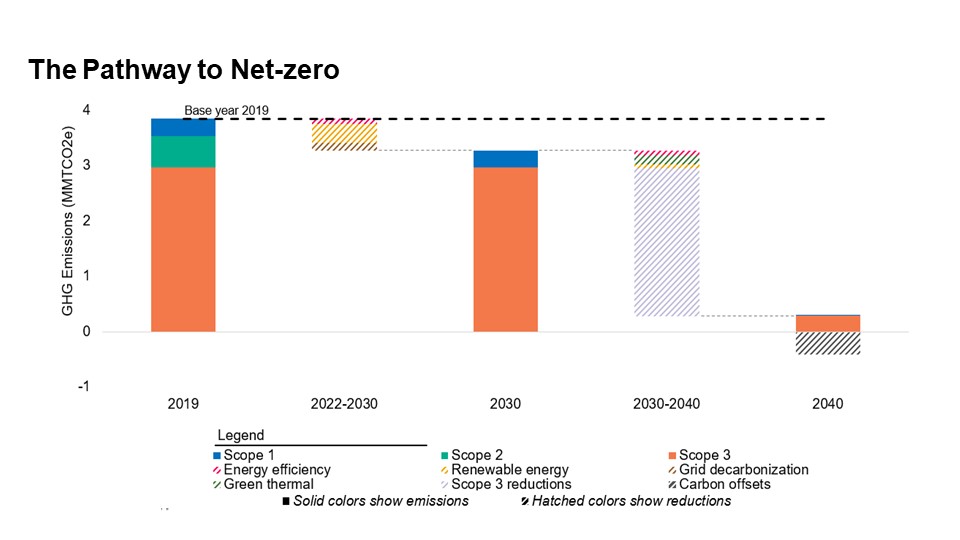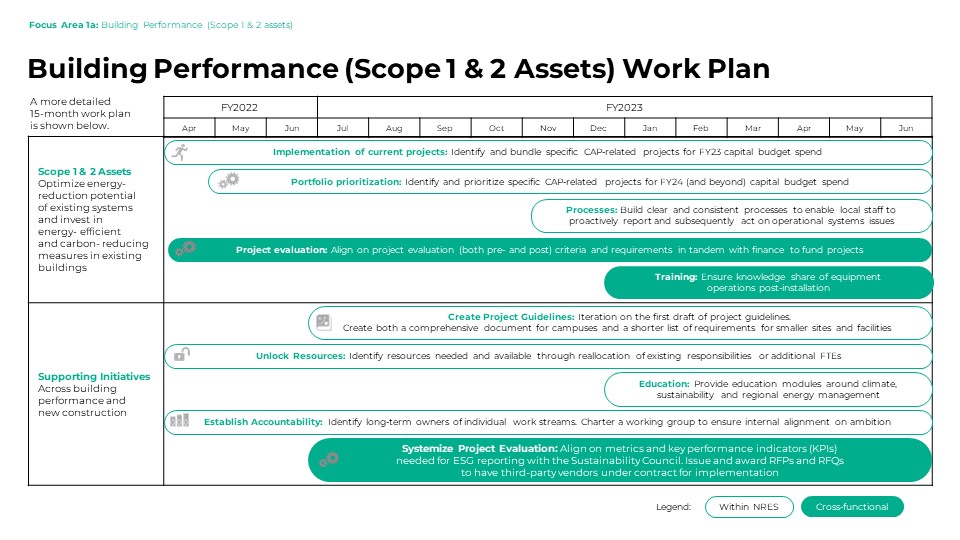A comprehensive path to net zero for large U.S. health system
CommonSpirit Health, United States
Case study summary
CommonSpirit gathered support for a net-zero ambition, as well as resource allocation to develop the organization’s climate action plan, which includes specific goals, strategies, and work plans under three pillars: buildings and operations, supply chain, and climate-resilient communities.
Demographic information
- City: Chicago
- State/province/region: Illinois
- Country: United States
- Type of institution: CommonSpirit Health is a nonprofit Catholic health system dedicated to advancing health for all people. It was created in February 2019 by Catholic Health Initiatives and Dignity Health. With its national office in Chicago and a team of more than 150,000 employees and 25,000 physicians and advanced practice clinicians, CommonSpirit operates 138 hospitals and more than 2,000 care sites across 21 states. In FY 2022, CommonSpirit had revenues of $33.9 billion and provided $4.9 billion in charity care, community benefit, and unreimbursed government programs.
- Number of full-time equivalent staff: 150,000 employees
- Number of inpatient beds: 14,834
- Patient population served annually
- Number of patients served:
- 3,544,078 inpatient days (FY 22)
- 9,907,309 outpatient visits (FY 22)
- Geographic area served: CommonSpirit Health is in 21 states (Washington, Oregon, California, Arizona, Nevada, Nebraska, Iowa, North Dakota, Minnesota, Wisconsin, Colorado, Kansas, New Mexico, Texas, Tennessee, Georgia, Kentucky, Ohio, West Virginia, Arkansas, Pennsylvania),
- Health equity concerns experienced by your population:
- Racial justice (structural and systemic racism)
- Various social drivers of health (from housing to hunger, education to employment, isolation to immigration, safe neighborhoods to climate change), particularly for vulnerable and underserved populations, (people of color, LGBTQ+, low-income, undocumented immigrants)
- Access to high-quality, culturally competent, affordable health care (including maternal health for moms who are people of color, availability of robust disparities data, and a diverse health care workforce)
- Number of patients served:

Our collective climate story requires health sector leadership, each doing our part, creatively stewarding our resources, and embracing innovation to protect our common home, especially for those already vulnerable to the impacts of a changing climate.
The issue
Committed to its healing mission, CommonSpirit believes there is an unbreakable bond between the health of the planet and the health of people. The system’s frontline providers witness the impacts of climate change on people, communities, and operations. CommonSpirit also recognizes the health sector is among the biggest contributors to the climate crisis.
As one of the nation’s largest health systems, CommonSpirit has a duty to lead by example. The health system’s climate action plan (CAP) is a proactive response and roadmap to improving its hospitals and community-based adaptation and resilience. Reaching net zero by 2040 requires a significant transformation in how CommonSpirit operates, engages its value chain, and meaningfully engages patients, employees, and communities to eliminate systemic health inequities while delivering sustainable, resilient, and climate-smart health care.
Health care system's goal
CommonSpirit has committed to reaching net zero by 2040 across all three scopes, with an interim goal of cutting operational emissions in half by 2030. By example and through inspiration, the CAP is CommonSpirit’s roadmap for how they will continue to demonstrate leadership within the health sector and to others around the world.
Below is a depiction of the system’s pathway to net zero and CAP finance overview.

Sustainable strategy implemented
Timing is a critical element to implementing a leadership strategy, in addition to the following:
- Organizational assets, culture, and readiness: Consider the values that drive organizational culture, financial and human resources, history in climate action, and the ability to do more.
- External factors, political landscape, and global movement: Leadership does not happen in a vacuum. Health leaders must understand the science, trends, push-pull factors, and policies, as well as policy gaps and key stakeholders with political influences. CommonSpirit aims to align strategies with the Paris Accord as their north star.
- Partnership engagement: Partners are key to help inform and support shared interests.
With a footprint across 21 states, CommonSpirit developed their CAP as a strategic solution to bring their organization under one common plan with coordination, support, and resources. CommonSpirit’s CAP ties to its health system’s strategy for 2026, with pillars focusing on “our people, our excellence, and our future.”
Implementation process
The CAP is a reflection of CommonSpirit 2026 strategic roadmap to advance their focus on “our people, our excellence, and our future.” A dedicated core team led a six-month process and engaged more than 100 leaders from the system, division, and hospital levels.
Driven by their commitment to advance health equity and environmental justice, CommonSpirit’s CAP is organized under three strategies:
- Buildings and operations: Reduce emissions across the entire portfolio through energy efficiency and renewable energy, with a focus on acute care facilities in underserved communities.
- Supply chain: Influence CommonSpirit’s value chain partners to set their own emission reduction targets, with an initial emphasis on procurement vendors.
- Climate resilient communities: Develop clinical best practices in the prevention and management of diseases amplified by climate change with special attention to vulnerable groups. Advance meaningful state and federal climate policies and other health equity and social drivers of health policies at the intersectionality of climate change. Establish community partners to build climate-resilient infrastructure and coordinated emergency responses.
The CAP was designed to include a governance structure; clear accountability and ownership for major work streams including incentive structures, cross-functional collaboration, and coordination across all CAP pillars and enablers; integration with other organizational processes and structures (such as budgeting); and decision-making with efficient and accurate flow of information (reports, meeting cadence).
Here is one example highlighting the system’s building performance work plan:

Tracking progress
CommonSpirit took deliberate approaches to understand and set a net-zero goal, successfully tracking its progress and completing the development of a CAP:
- Developed directional GHG footprint to align with U.S. National Resources Defence Council (NRDC) and Paris Accord and integrated ambition to develop a high-level business case to advance the system’s mission and strategic vision.
- Facilitated four innovation labs (buildings and operations, supply chain, climate resilient communities, and finance) and gathered data to create inventory and management tools.
- Launched task forces comprised of smaller groups of four to six people who met weekly over three months to develop detailed goals, strategies, and work plans with three key pillars: buildings and operations, supply chain, and climate-resilient communities.
- Prepared materials for internal and external communications.
- Established regular monitoring and evaluation mechanisms of the CAP to ensure progress:
- The CAP core team had oversight of the task forces and was accountable to each other for the development of the pillar work plans, meeting routinely over the course of six months. The team meets on a quarterly basis to provide updates, collaborate on work plans, evaluate progress, and course correct as needed. The team is currently in the process of determining a new vendor for a GHG dashboard.
- Tracking progress has evolved to include biennial reporting to the CommonSpirit Sustainability Council and the Board of Stewardship Trustees. Progress is also annually published in the system’s publicly available sustainability report and tracked in the annual Climate Disclosure Project filing.

We are all called to health justice and climate leadership. In big and small ways we can make a difference now and for the future of our children and the generations to come.
Progress achieved
Progress achieved includes the development of a CAP with these key goals:
- 2019: Baseline GHG footprint (3.5 MMTCO₂e)
- 2025: Have engaged top 30 health care vendors to begin acting on climate
- 2026: Have developed health equity strategies in the clinical, community, and public policy settings
- 2030: Have reduced operational emissions by 50%; have engaged top 67% of vendors to establish science-aligned targets for their scope 1 and 2 emissions; and have advanced clinical best practices associated with climate effects on health and created climate resilient communities across the service area
- 2040: Have achieved net-zero GHG emissions across the entire buildings portfolio; have achieved 90% absolute reduction in scope 3 emissions; have excelled in delivering consistent clinical practices and partnering with others to improve community health and support the goals of the Paris Accord.
Challenges and lessons learned
CommonSpirit lifts up these leadership learnings:
- “The way out is in” (Thich Nhat Hahn). It begins with each health care system doing its part to tell their unique climate story.
- Be realistic in setting goals: Evaluate not only emissions inventory but also the existing resources and business strategies that will enable success.
- Share the joy: Prepare to share the CAP internally and externally with others. People will need help understanding why they should care about addressing climate change and the difference they can make.
- “Leaders adjusts the sail” (John Maxwell) A climate action plan must be a strategic effort to not only weather the externalities that present themselves but also that enable leaders to successfully adapt and show the way forward.

Developing our net-zero goal and Climate Action Plan are integral to who we are as a healing mission and reflect CommonSpirit Health’s steadfast commitment to environmental sustainability while creating a healthier future for all.
Next steps
First-year implementation is focused on the following next steps:
- FY 24 budget resource allocation for CAP implementation, including how to receive dollars from the Inflation Reduction Act.
- Further refinement of work plans under three pillars, including meeting the HHS health sector climate pledge.
- Continued education and communication of CAP with the executive team and division and hospital leaders.
- Engaged opportunities to share the story with the health care sector and other key stakeholders, including businesses and particularly supply chain partners, as well as policymakers and community leaders.
Links
- Health system website
- CommonSpirit Announces Industry-Leading Commitment to Reach Net-Zero by 2040
- VIDEO: New Climate Commitment | CommonSpirit Health
- Hospitals and sustainability: CommonSpirit Health’s Shelly Schlenker says ‘it’s about your patients’
- CommonSpirit Health: 2022 Climate Action Plan
- Nearly 400 companies urge the U.S. Senate to unleash the Build Back Better Act's historic investments in climate, clean jobs, savings and…
- Business Support Statement for the Inflation Reduction Act
- FACT SHEET: Health Sector Leaders Join Biden Administration’s Pledge to Reduce Greenhouse Gas Emissions 50% by 2030
- National Academy of Medicine: Action Collaborative on Decarbonizing the U.S. Health Sector
- These Communities, Business, and Institutions Have Made Commitments To Go ‘All In’ On Climate